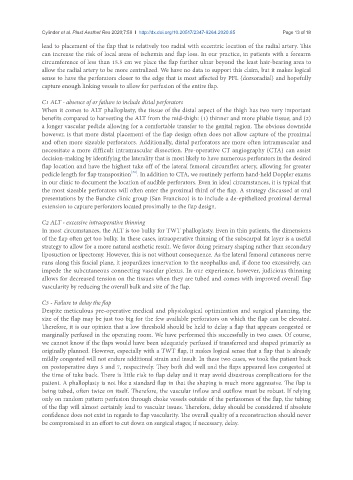Page 679 - Read Online
P. 679
Cylinder et al. Plast Aesthet Res 2020;7:58 I http://dx.doi.org/10.20517/2347-9264.2020.85 Page 13 of 18
lead to placement of the flap that is relatively too radial with eccentric location of the radial artery. This
can increase the risk of local areas of ischemia and flap loss. In our practice, in patients with a forearm
circumference of less than 15.5 cm we place the flap further ulnar beyond the least hair-bearing area to
allow the radial artery to be more centralized. We have no data to support this claim, but it makes logical
sense to have the perforators closer to the edge that is most affected by PFL (dorsoradial) and hopefully
capture enough linking vessels to allow for perfusion of the entire flap.
C1 ALT - absence of or failure to include distal perforators
When it comes to ALT phalloplasty, the tissue of the distal aspect of the thigh has two very important
benefits compared to harvesting the ALT from the mid-thigh: (1) thinner and more pliable tissue; and (2)
a longer vascular pedicle allowing for a comfortable transfer to the genital region. The obvious downside
however, is that more distal placement of the flap design often does not allow capture of the proximal
and often more sizeable perforators. Additionally, distal perforators are more often intramuscular and
necessitate a more difficult intramuscular dissection. Pre-operative CT angiography (CTA) can assist
decision-making by identifying the laterality that is most likely to have numerous perforators in the desired
flap location and have the highest take off of the lateral femoral circumflex artery, allowing for greater
[31]
pedicle length for flap transposition . In addition to CTA, we routinely perform hand-held Doppler exams
in our clinic to document the location of audible perforators. Even in ideal circumstances, it is typical that
the most sizeable perforators will often enter the proximal third of the flap. A strategy discussed at oral
presentations by the Buncke clinic group (San Francisco) is to include a de-epithelized proximal dermal
extension to capture perforators located proximally to the flap design.
C2 ALT - excessive intraoperative thinning
In most circumstances, the ALT is too bulky for TWT phalloplasty. Even in thin patients, the dimensions
of the flap often get too bulky. In these cases, intraoperative thinning of the subscarpal fat layer is a useful
strategy to allow for a more natural aesthetic result. We favor doing primary shaping rather than secondary
liposuction or lipectomy. However, this is not without consequence. As the lateral femoral cutaneous nerve
runs along this fascial plane, it jeopardizes innervation to the neophallus and, if done too excessively, can
impede the subcutaneous connecting vascular plexus. In our experience, however, judicious thinning
allows for decreased tension on the tissues when they are tubed and comes with improved overall flap
vascularity by reducing the overall bulk and size of the flap.
C3 - Failure to delay the flap
Despite meticulous pre-operative medical and physiological optimization and surgical planning, the
size of the flap may be just too big for the few available perforators on which the flap can be elevated.
Therefore, it is our opinion that a low threshold should be held to delay a flap that appears congested or
marginally perfused in the operating room. We have performed this successfully in two cases. Of course,
we cannot know if the flaps would have been adequately perfused if transferred and shaped primarily as
originally planned. However, especially with a TWT flap, it makes logical sense that a flap that is already
mildly congested will not endure additional strain and insult. In these two cases, we took the patient back
on postoperative days 5 and 7, respectively. They both did well and the flaps appeared less congested at
the time of take back. There is little risk to flap delay and it may avoid disastrous complications for the
patient. A phalloplasty is not like a standard flap in that the shaping is much more aggressive. The flap is
being tubed, often twice on itself. Therefore, the vascular inflow and outflow must be robust. If relying
only on random pattern perfusion through choke vessels outside of the perfasomes of the flap, the tubing
of the flap will almost certainly lead to vascular issues. Therefore, delay should be considered if absolute
confidence does not exist in regards to flap vascularity. The overall quality of a reconstruction should never
be compromised in an effort to cut down on surgical stages; if necessary, delay.

